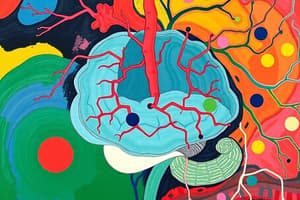Podcast
Questions and Answers
What structures primarily receive innervation from the parasympathetic division?
What structures primarily receive innervation from the parasympathetic division?
- Skin and skeletal muscles
- Adrenal glands and kidneys
- Head and thoracic viscera (correct)
- Liver and gallbladder
Which cranial nerve carries the majority of parasympathetic output?
Which cranial nerve carries the majority of parasympathetic output?
- Cranial nerve IX
- Cranial nerve X (correct)
- Cranial nerve III
- Cranial nerve VII
Which statement accurately describes the efferent pathways in the sympathetic division?
Which statement accurately describes the efferent pathways in the sympathetic division?
- Each preganglionic axon synapses with only one ganglionic cell.
- They have longer postganglionic axons than preganglionic axons.
- They synapse onto many ganglionic cells, typically 24 or more. (correct)
- Preganglionic axons do not branch significantly.
What is a primary effect of sympathetic activation on body systems?
What is a primary effect of sympathetic activation on body systems?
Which of the following cranial nerves is involved in the parasympathetic control of salivary glands?
Which of the following cranial nerves is involved in the parasympathetic control of salivary glands?
What is the primary role of the sympathetic division of the autonomic nervous system?
What is the primary role of the sympathetic division of the autonomic nervous system?
Which of the following is an effect of parasympathetic activation on the heart?
Which of the following is an effect of parasympathetic activation on the heart?
What represents the structure of the efferent pathways in the autonomic nervous system?
What represents the structure of the efferent pathways in the autonomic nervous system?
How does the sympathetic division affect the digestive tract?
How does the sympathetic division affect the digestive tract?
Which cranial nerve is primarily associated with parasympathetic functions?
Which cranial nerve is primarily associated with parasympathetic functions?
Which effectors receive sympathetic input only?
Which effectors receive sympathetic input only?
What happens to the bronchial passages during sympathetic activation?
What happens to the bronchial passages during sympathetic activation?
Which statement about the autonomic nervous system's dual innervation is accurate?
Which statement about the autonomic nervous system's dual innervation is accurate?
What is a characteristic of the sympathetic division of the autonomic nervous system?
What is a characteristic of the sympathetic division of the autonomic nervous system?
Where do the preganglionic neurons of the parasympathetic division originate?
Where do the preganglionic neurons of the parasympathetic division originate?
Which statement accurately describes the organization of the sympathetic nervous system?
Which statement accurately describes the organization of the sympathetic nervous system?
What effect does activation of the sympathetic division generally have on the body?
What effect does activation of the sympathetic division generally have on the body?
Which of the following structures is part of the sympathetic nervous system?
Which of the following structures is part of the sympathetic nervous system?
Which ganglia are located close to large abdominal arteries and are part of the sympathetic division?
Which ganglia are located close to large abdominal arteries and are part of the sympathetic division?
Which statement best describes the function of the adrenal medulla in the sympathetic nervous system?
Which statement best describes the function of the adrenal medulla in the sympathetic nervous system?
What is the primary role of cranial nerves in the parasympathetic division?
What is the primary role of cranial nerves in the parasympathetic division?
Flashcards
Autonomic Nervous System (ANS)
Autonomic Nervous System (ANS)
Part of the peripheral nervous system that controls involuntary functions like heart rate and digestion.
Sympathetic Division
Sympathetic Division
Division of the ANS that prepares the body for action or stress (fight-or-flight).
Parasympathetic Division
Parasympathetic Division
Division of the ANS that promotes relaxation and restoration (rest-and-digest).
Dual Innervation
Dual Innervation
Signup and view all the flashcards
Central Nervous System (CNS)
Central Nervous System (CNS)
Signup and view all the flashcards
Hypothalamus
Hypothalamus
Signup and view all the flashcards
Efferent Pathway
Efferent Pathway
Signup and view all the flashcards
Single Innervation
Single Innervation
Signup and view all the flashcards
Intramural Ganglia
Intramural Ganglia
Signup and view all the flashcards
Parasympathetic Control of Pupil and Lens
Parasympathetic Control of Pupil and Lens
Signup and view all the flashcards
Vagus Nerve's Parasympathetic Role
Vagus Nerve's Parasympathetic Role
Signup and view all the flashcards
Sympathetic Activation: Widespread Effects
Sympathetic Activation: Widespread Effects
Signup and view all the flashcards
Parasympathetic Activation: Localized Effects
Parasympathetic Activation: Localized Effects
Signup and view all the flashcards
Where are sympathetic preganglionic cell bodies?
Where are sympathetic preganglionic cell bodies?
Signup and view all the flashcards
What are sympathetic chain ganglia?
What are sympathetic chain ganglia?
Signup and view all the flashcards
What are collateral ganglia?
What are collateral ganglia?
Signup and view all the flashcards
What is the adrenal medulla?
What is the adrenal medulla?
Signup and view all the flashcards
Where are parasympathetic preganglionic neuron cell bodies?
Where are parasympathetic preganglionic neuron cell bodies?
Signup and view all the flashcards
What are the effects of parasympathetic division?
What are the effects of parasympathetic division?
Signup and view all the flashcards
What are pelvic nerves?
What are pelvic nerves?
Signup and view all the flashcards
What are the key differences between sympathetic and parasympathetic preganglionic axons?
What are the key differences between sympathetic and parasympathetic preganglionic axons?
Signup and view all the flashcards
Study Notes
Document Information
- Document title: B223-14-Autonomi...
- Document identifier: B223-14-Autonomic-converted
- Date: December 2, 2021
- Time: 2:22 PM
Studying That Suits You
Use AI to generate personalized quizzes and flashcards to suit your learning preferences.




